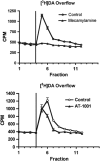AT-1001: a high affinity and selective α3β4 nicotinic acetylcholine receptor antagonist blocks nicotine self-administration in rats
- PMID: 22278092
- PMCID: PMC3327842
- DOI: 10.1038/npp.2011.322
AT-1001: a high affinity and selective α3β4 nicotinic acetylcholine receptor antagonist blocks nicotine self-administration in rats
Abstract
Genomic and pharmacologic data have suggested the involvement of the α3β4 subtype of nicotinic acetylcholine receptors (nAChRs) in drug seeking to nicotine and other drugs of abuse. In order to better examine this receptor subtype, we have identified and characterized the first high affinity and selective α3β4 nAChR antagonist, AT-1001, both in vitro and in vivo. This is the first reported compound with a Ki below 10 nM at α3β4 nAChR and >90-fold selectivity over the other major subtypes, the α4β2 and α7 nAChR. AT-1001 competes with epibatidine, allowing for [³H]epibatidine binding to be used for structure-activity studies, however, both receptor binding and ligand-induced Ca²⁺ flux are not strictly competitive because increasing ligand concentration produces an apparent decrease in receptor number and maximal Ca²⁺ fluorescence. AT-1001 also potently and reversibly blocks epibatidine-induced inward currents in HEK cells transfected with α3β4 nAChR. Importantly, AT-1001 potently and dose-dependently blocks nicotine self-administration in rats, without affecting food responding. When tested in a nucleus accumbens (NAcs) synaptosomal preparation, AT-1001 inhibits nicotine-induced [³H]dopamine release poorly and at significantly higher concentrations compared with mecamylamine and conotoxin MII. These results suggest that its inhibition of nicotine self-administration in rats is not directly due to a decrease in dopamine release from the NAc, and most likely involves an indirect pathway requiring α3β4 nAChR. In conclusion, our studies provide further evidence for the involvement of α3β4 nAChR in nicotine self-administration. These findings suggest the utility of this receptor as a target for smoking cessation medications, and highlight the potential of AT-1001 and congeners as clinically useful compounds.
Figures







Similar articles
-
The α3β4 nAChR partial agonist AT-1001 attenuates stress-induced reinstatement of nicotine seeking in a rat model of relapse and induces minimal withdrawal in dependent rats.Behav Brain Res. 2017 Aug 30;333:251-257. doi: 10.1016/j.bbr.2017.07.004. Epub 2017 Jul 8. Behav Brain Res. 2017. PMID: 28693859 Free PMC article.
-
Receptor protection studies comparing recombinant and native nicotinic receptors: Evidence for a subpopulation of mecamylamine-sensitive native alpha3beta4* nicotinic receptors.Neurosci Lett. 2006 Jan 9;392(1-2):135-9. doi: 10.1016/j.neulet.2005.09.002. Epub 2005 Sep 29. Neurosci Lett. 2006. PMID: 16198480
-
AT-1001: a high-affinity α3β4 nAChR ligand with novel nicotine-suppressive pharmacology.Br J Pharmacol. 2015 Apr;172(7):1834-45. doi: 10.1111/bph.13034. Epub 2015 Jan 23. Br J Pharmacol. 2015. PMID: 25440006 Free PMC article.
-
Nicotinic receptor antagonists as treatments for nicotine abuse.Adv Pharmacol. 2014;69:513-51. doi: 10.1016/B978-0-12-420118-7.00013-5. Adv Pharmacol. 2014. PMID: 24484986 Free PMC article. Review.
-
The subtypes of nicotinic acetylcholine receptors on dopaminergic terminals of mouse striatum.Biochem Pharmacol. 2007 Oct 15;74(8):1235-46. doi: 10.1016/j.bcp.2007.07.032. Epub 2007 Jul 27. Biochem Pharmacol. 2007. PMID: 17825262 Free PMC article. Review.
Cited by
-
What We Have Gained from Ibogaine: α3β4 Nicotinic Acetylcholine Receptor Inhibitors as Treatments for Substance Use Disorders.J Med Chem. 2023 Jan 12;66(1):107-121. doi: 10.1021/acs.jmedchem.2c01562. Epub 2022 Nov 28. J Med Chem. 2023. PMID: 36440853 Free PMC article. Review.
-
In Silico Finding of Key Interaction Mediated α3β4 and α7 Nicotinic Acetylcholine Receptor Ligand Selectivity of Quinuclidine-Triazole Chemotype.Int J Mol Sci. 2020 Aug 27;21(17):6189. doi: 10.3390/ijms21176189. Int J Mol Sci. 2020. PMID: 32867140 Free PMC article.
-
Functional characterization of AT-1001, an α3β4 nicotinic acetylcholine receptor ligand, at human α3β4 and α4β2 nAChR.Nicotine Tob Res. 2015 Mar;17(3):361-7. doi: 10.1093/ntr/ntu170. Epub 2014 Sep 1. Nicotine Tob Res. 2015. PMID: 25180076 Free PMC article.
-
Accumbens Cholinergic Interneurons Mediate Cue-Induced Nicotine Seeking and Associated Glutamatergic Plasticity.eNeuro. 2021 Feb 9;8(1):ENEURO.0276-20.2020. doi: 10.1523/ENEURO.0276-20.2020. Print 2021 Jan-Feb. eNeuro. 2021. PMID: 33239269 Free PMC article.
-
Nicotinic acetylcholine receptor antagonists alter the function and expression of serine racemase in PC-12 and 1321N1 cells.Cell Signal. 2013 Dec;25(12):2634-45. doi: 10.1016/j.cellsig.2013.08.025. Epub 2013 Sep 4. Cell Signal. 2013. PMID: 24012499 Free PMC article.
References
-
- Belluzzi JD, Wang R, Leslie FM. Acetaldehyde enhances acquisition of nicotine self-administration in adolescent rats. Neuropsychopharmacology. 2005;30:705–712. - PubMed
-
- Cao J, Belluzzi JD, Loughlin SE, Keyler DE, Pentel PR, Leslie FM. Acetaldehyde, a major constituent of tobacco smoke, enhances behavioral, endocrine, and neuronal responses to nicotine in adolescent and adult rats. Neuropsychopharmacology. 2007;32:2025–2035. - PubMed
Publication types
MeSH terms
Substances
Grants and funding
LinkOut - more resources
Full Text Sources
Other Literature Sources
Miscellaneous

